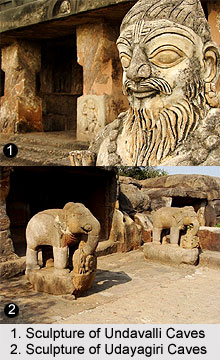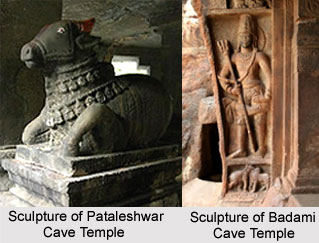 Indian cave temple sculpture evolved in India in the 2nd century BC and continued till the 7th century AD. It was actually with the arrival of Buddhism that the cave sculptures emerged in India. The monolithic rocks were actually carved out and given the form of cave temples. The earliest caves constructed were the Kanheri Caves, Maharashtra. The sculpture of Kanheri Caves includes beautiful reliefs.
Indian cave temple sculpture evolved in India in the 2nd century BC and continued till the 7th century AD. It was actually with the arrival of Buddhism that the cave sculptures emerged in India. The monolithic rocks were actually carved out and given the form of cave temples. The earliest caves constructed were the Kanheri Caves, Maharashtra. The sculpture of Kanheri Caves includes beautiful reliefs.
Another remarkable instance of Indian cave temple sculpture can be found in the Ajanta caves. There are numerous cave temples that are scattered throughout India and reflect the splendour and the artistic brilliance of the sub continent. These are:
| Sculpture of Undavalli Caves, Andhra Pradesh | Sculpture of Kaviyoor Caves, Kerala | Sculpture of Karla Caves, Maharashtra | Sculpture of Patal Bhuvaneshwar Cave, Uttarakhand |
| Sculpture of Lomasrishi Caves, Bihar | Sculpture of Edakkal Caves, Kerala | Sculpture of Kailash Caves, Maharashtra | Sculpture of Bhaja Caves,Maharashtra |
| Sculpture of Sudama Caves, Bihar | Sculpture of Bagh Caves, Madhya Pradesh | Sculpture of Pandavleni Caves, Maharashtra | Sculpture of Mandapeshwar Caves, Maharashtra |
| Sculpture of Udaygiri and Khandagiri Caves, Orissa | Sculpture at Elephanta Caves, Maharashtra | Sculpture of Pataleshwar Cave Temple, Maharashtra | Sculpture of Gavi Gangadhareshwara Cave, Karnataka |
| Sculpture of Aihole Caves, Karnataka | Sculpture at Ellora Caves, Maharashtra | Sculpture of Narthamalai Cave, Tamil Nadu | Sculpture of Bedse Caves, Maharashtra |
| Sculpture of Badami Caves, Karnataka | Sculpture of Jogeshwari Caves, Maharashtra | Sculpture of Varaha Cave Temple, Tamil Nadu | Sculpture of Mahakali Caves, Maharashtra |
 Badami cave temples: The first cave has an 18-armed Lord Nataraja that comprises a series of arches. The second cave is situated on a sandstone hill. It is dedicated to lord Vishnu who is portrayed here as a dwarf or `Trivikrama` of awesome proportions with one foot getting command over the earth and the other the sky. The other attractive features of this cave are the depictions of Lord Vishnu with a serpent, Vishnu as Narasimha (Vishnu as Man-Lion), Varaha, Harihara (Shiva, Vishnu) and Vishnu as Trivikrama. The wonderful artistry and sculptural brilliance makes this cave a masterpiece of Deccan art. It provides a detailed portrayal of the art and culture of the 6th century, specially costumes, jewelry, hairstyle, lifestyle and the like. All the three caves so far mentioned are Hindu caves. The fourth cave is the only Jain cave whose construction started in the 6th century and was completed nearly 100 years later than the earlier three caves. Here one can see the carvings of the 24th Tirthankara Parshavnatha with a serpent at his feet as well as Mahavira in a sitting position.
Badami cave temples: The first cave has an 18-armed Lord Nataraja that comprises a series of arches. The second cave is situated on a sandstone hill. It is dedicated to lord Vishnu who is portrayed here as a dwarf or `Trivikrama` of awesome proportions with one foot getting command over the earth and the other the sky. The other attractive features of this cave are the depictions of Lord Vishnu with a serpent, Vishnu as Narasimha (Vishnu as Man-Lion), Varaha, Harihara (Shiva, Vishnu) and Vishnu as Trivikrama. The wonderful artistry and sculptural brilliance makes this cave a masterpiece of Deccan art. It provides a detailed portrayal of the art and culture of the 6th century, specially costumes, jewelry, hairstyle, lifestyle and the like. All the three caves so far mentioned are Hindu caves. The fourth cave is the only Jain cave whose construction started in the 6th century and was completed nearly 100 years later than the earlier three caves. Here one can see the carvings of the 24th Tirthankara Parshavnatha with a serpent at his feet as well as Mahavira in a sitting position.



